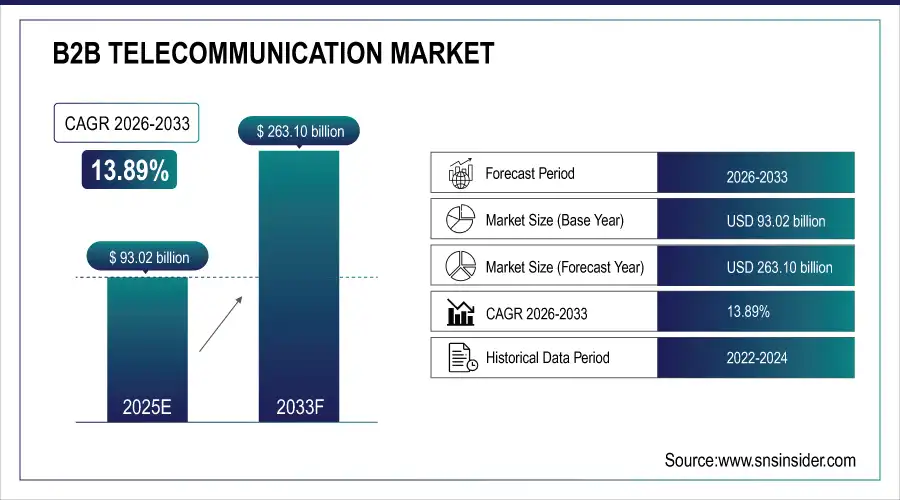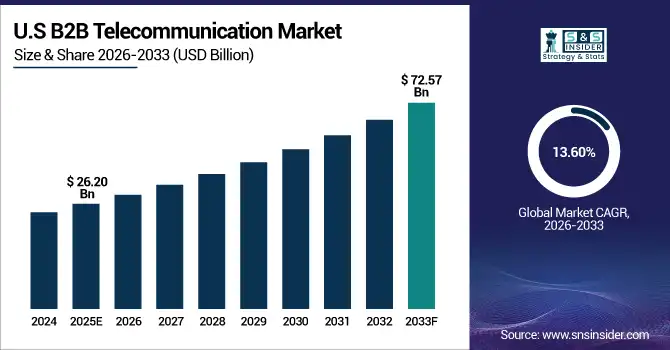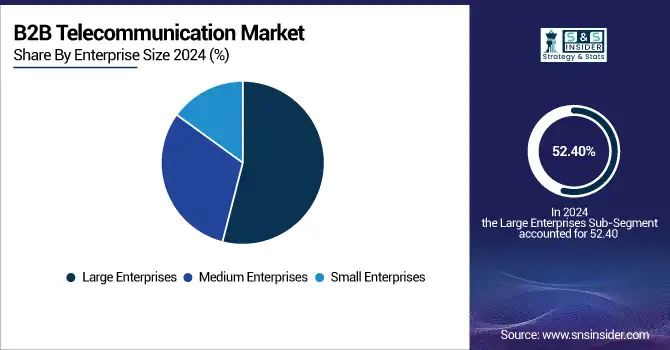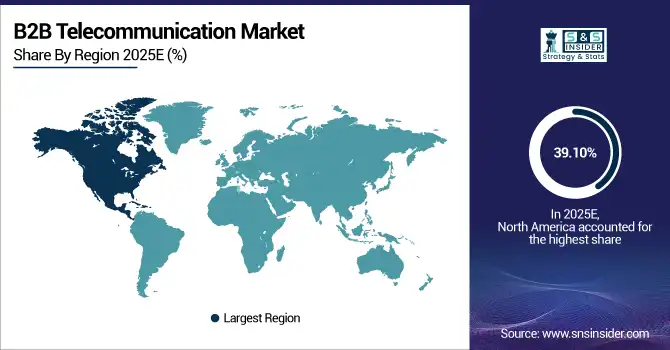B2B Telecommunication Market Report Scope & Overview:
The B2B Telecommunication Market Size was valued at USD 93.02 Billion in 2025E and is expected to reach USD 263.10 Billion by 2033 and grow at a CAGR of 13.89% over the forecast period 2026-2033.
The B2B Telecommunication Market analysis growth is driven by the rising demand for high-speed, reliable connectivity among enterprises across industries. The increasing adoption of cloud computing, managed network services, and unified communication platforms has accelerated the need for robust telecom infrastructure. Businesses are investing heavily in digital transformation initiatives, such as AI-powered communication tools, IoT connectivity, and SD-WAN solutions, to improve operational efficiency, reduce costs, and enhance collaboration. Additionally, the rapid expansion of 5G networks and the growing emphasis on remote work and hybrid working models are fueling enterprise demand for flexible, scalable telecom solutions. According to study, around 60–65% of enterprises have adopted or are planning to adopt cloud computing, managed network services, or unified communication platforms.
Market Size and Forecast:
-
Market Size in 2025: USD 93.02 Billion
-
Market Size by 2033: USD 263.10 Billion
-
CAGR: 13.89% from 2026 to 2033
-
Base Year: 2025
-
Forecast Period: 2026–2033
-
Historical Data: 2022–2024

To Get more information on B2B Telecommunication Market - Request Free Sample Report
B2B Telecommunication Market Trends
-
Increasing pet ownership drives higher spending on preventive and wellness products globally.
-
Companion animal “humanization” boosts demand for advanced diagnostics and veterinary services.
-
Tele-veterinary services expand access to veterinary care in remote or underserved areas.
-
Adoption of AI-driven diagnostics improves early disease detection and animal health monitoring.
-
Wearable sensors and IoT devices enhance preventive care for pets and livestock.
-
Digital health platforms reduce costs and time, supporting efficient veterinary consultations.
The U.S. B2B Telecommunication Market size was USD 26.20 Billion in 2025E and is expected to reach USD 72.57 Billion by 2033, growing at a CAGR of 13.60% over the forecast period of 2026-2033, driven by the adoption of cloud-based services, 5G infrastructure, and AI-driven solutions across industries. Key players like AT&T, Verizon, and T-Mobile are expanding their enterprise offerings through strategic acquisitions and partnerships.

B2B Telecommunication Market Growth Drivers:
-
Enterprises Embrace Cloud Services for Scalable, Efficient, and Collaborative Telecom
driven by the increasing adoption of cloud computing, managed network services, and unified communication platforms among enterprises. Businesses are seeking solutions that can provide scalability, cost efficiency, and enhanced collaboration across multiple locations. Cloud-based telecom services enable companies to streamline operations, reduce IT infrastructure costs, and integrate AI-powered tools such as chatbots, virtual assistants, and predictive analytics into their communication systems. Managed network services also provide 24/7 monitoring, security, and maintenance, which reduces operational downtime and allows enterprises to focus on core business activities. As a result, the demand for flexible, secure, and reliable telecom solutions continues to grow across IT, healthcare, financial services, and retail sectors.
Enterprises leveraging cloud-based telecom solutions can achieve 20–25% reduction in IT infrastructure costs.
B2B Telecommunication Market Restraints:
-
High Deployment Costs and Complexity Challenge Small and Medium Enterprises Adoption
Despite its growth potential, the market faces restraints due to the high upfront costs associated with deploying advanced telecom solutions such as SD-WAN, IoT connectivity, or private cloud communication platforms. Many small and medium enterprises (SMEs) find it challenging to invest in hardware, software licenses, and skilled personnel for setup and maintenance. Additionally, integrating multiple services (like IP telephony, VPN, and managed networks) into a unified platform often involves complex configuration and interoperability issues, which can lead to delays or technical inefficiencies. These challenges can limit adoption among enterprises with restricted budgets or limited technical expertise, slowing down market penetration in certain regions.
B2B Telecommunication Market Opportunities:
-
5G Networks and Remote Work Unlock New Telecom Growth Potential
The rapid rollout of 5G networks presents a significant growth opportunity for the B2B Telecommunication Market. 5G offers ultra-low latency, higher bandwidth, and improved reliability, which are crucial for enterprises adopting IoT, cloud communication, and AI-based collaboration tools. Additionally, the global shift toward remote and hybrid work models has increased demand for secure, high-speed, and flexible telecom solutions that support distributed workforces. Enterprises can leverage 5G-enabled networks to enhance real-time communication, virtual meetings, and data-intensive applications, creating opportunities for telecom providers to introduce value-added services, managed cloud solutions, and customized connectivity plans. Emerging economies, particularly in the Asia-Pacific region, also represent a rapidly growing customer base due to increasing digital adoption and telecom infrastructure investments.
Emerging economies in the Asia-Pacific region account for roughly 35–40% of new enterprise telecom deployments.
B2B Telecommunication Market Segmentation Analysis:
-
By Service Type: In 2025, Data Services led the market with a share of 35.40%, while Cloud Communication Services is the fastest-growing segment with a CAGR of 20.10%.
-
By Deployment Model: In 2025, Cloud-Based Deployment led the market with a share of 48.60%, while it is also the fastest-growing segment with a CAGR of 18.50%.
-
By Enterprise Size: In 2025, Large Enterprises led the market with a share of 52.40%, while Small Enterprises is the fastest-growing segment with a CAGR of 16.80%.
-
By Connectivity Solutions: In 2025, IP Telephony led the market with a share of 34.10%, while Wireless Communication is the fastest-growing segment with a CAGR of 15.30%.
-
By Industry Verticals: In 2025, IT and Technology led the market with a share of 29.40%, while it is also the fastest-growing segment with a CAGR of 14.80%.
By Enterprise Size, Large Enterprises Lead Market and Small Enterprises Fastest Growth
Large Enterprises lead the market due to their extensive communication needs, multi-location operations, and higher IT budgets that enable them to adopt advanced telecom solutions, including managed networks, cloud-based platforms, and unified communication systems. Large organizations across sectors such as IT, healthcare, financial services, and retail require secure, high-capacity, and reliable connectivity to support critical business operations and real-time collaboration. Meanwhile, Small Enterprises represent the fastest-growing segment, driven by increasing digital adoption, affordable cloud-based solutions, and scalable telecom services that allow smaller businesses to enhance productivity and connectivity without heavy infrastructure investments. The combined demand highlights the market’s focus on flexible, scalable, and cost-efficient telecom solutions for businesses of all sizes.

By Service Type, Data Services Lead Market and Cloud Communication Services Fastest Growth
Data Services lead the market due to their critical role in enabling enterprises to transmit, store, and analyze large volumes of business data efficiently. Organizations across IT, healthcare, financial services, and retail increasingly rely on data-driven operations, making high-speed, secure, and reliable data services indispensable. Simultaneously, Cloud Communication Services represent the fastest-growing segment, driven by the rising adoption of remote work, hybrid work models, and AI-enabled collaboration tools. Cloud-based platforms offer scalability, cost efficiency, and seamless integration with existing IT infrastructure, allowing businesses to enhance communication, improve operational efficiency, and support multi-location collaboration. The combined demand for both segments underscores the market’s focus on flexible, secure, and technologically advanced telecom solutions.
By Deployment Model, Cloud-Based Deployment Lead Market with Fastest Growth
Cloud-Based Deployment leads the market as enterprises increasingly shift from traditional on-premises systems to scalable, flexible cloud infrastructure. Cloud-based solutions provide enhanced accessibility, cost efficiency, and seamless integration with existing IT environments, enabling businesses to streamline operations across multiple locations and improve overall productivity. Simultaneously, Cloud-Based Deployment is also the fastest-growing segment, fueled by the adoption of remote and hybrid work models, AI-driven communication tools, and managed network services. The rapid deployment of secure, high-performance cloud networks allows enterprises to scale services quickly, reduce operational overhead, and support data-intensive applications, making cloud-based deployment a cornerstone of the evolving B2B telecom ecosystem.
By Connectivity Solutions, IP Telephony Lead Market and Wireless Communication Fastest Growth
Internet Protocol (IP) Telephony leads the market as it enables enterprises to streamline voice communication, reduce operational costs, and integrate with unified communication platforms across multiple locations. IP Telephony is widely adopted by large organizations in IT, healthcare, financial services, and retail sectors due to its reliability, scalability, and compatibility with cloud-based and managed network services. Meanwhile, Wireless Communication represents the fastest-growing segment, driven by the increasing adoption of mobile devices, remote work, and IoT-enabled enterprise applications. Wireless solutions offer flexibility, real-time connectivity, and seamless integration with modern telecom infrastructure, allowing businesses to support distributed teams, enhance collaboration, and future-proof their communication networks efficiently.
By Industry Verticals, IT and Technology Lead Market with Fastest Growth
The IT and Technology vertical leads the market due to its high demand for advanced communication solutions, cloud-based services, and secure, high-speed connectivity to support global operations, data-intensive applications, and real-time collaboration. Enterprises in this sector are increasingly leveraging managed networks, AI-powered communication tools, and SD-WAN solutions to enhance efficiency and reduce operational costs. Simultaneously, the IT and Technology vertical is the fastest-growing segment, driven by the continuous adoption of digital transformation initiatives, hybrid work models, and IoT-enabled devices. The rapid integration of scalable and flexible telecom solutions in IT and Technology companies highlights the vertical’s pivotal role in shaping the growth and evolution of the B2B telecom market.
B2B Telecommunication Market Regional Analysis:
North America B2B Telecommunication Market Insights:
The North America dominated the B2B Telecommunication Market in 2025E, with over 39.10% revenue share, due to its advanced infrastructure, high enterprise adoption of cloud-based services, and widespread 5G network deployment. The region’s IT, healthcare, financial services, and retail sectors are increasingly investing in managed network services, unified communication platforms, and AI-driven communication tools to enhance operational efficiency and collaboration. Strong government support, favorable regulations, and high digital literacy further accelerate adoption. Additionally, the rapid shift toward remote and hybrid work models is boosting demand for flexible, scalable, and secure telecom solutions, making North America a key growth hub in the global B2B telecom landscape.

Get Customized Report as per Your Business Requirement - Enquiry Now
-
U.S. B2B Telecommunication Market Insight
The U.S. and Canada lead in driven by advanced infrastructure, high enterprise adoption of cloud and managed services, 5G expansion, and growing demand for secure, scalable, and flexible communication solutions.
Asia Pacific B2B Telecommunication Market Insights:
The Asia-Pacific region is expected to have the fastest-growing CAGR 15.22%, driven by rapid digital adoption, rising enterprise investments in cloud-based communication, and expanding 5G infrastructure. The region is witnessing strong demand for managed network services, IP telephony, and wireless communication solutions to support various industry verticals such as IT, manufacturing, healthcare, and retail. Growing adoption of scalable, cost-efficient telecom solutions among small and medium enterprises is further boosting market growth. Additionally, government initiatives promoting digitalization and advanced network infrastructure are accelerating technology deployment, positioning Asia-Pacific as a high-potential region for B2B telecom providers seeking rapid market expansion.
-
China and India B2B Telecommunication Market Insight
The China and India B2B Telecommunication Market is rapidly growing, fueled by digital adoption, cloud-based services, 5G deployment, rising enterprise connectivity demand, and expanding small and medium enterprise adoption of scalable telecom solutions.
Europe B2B Telecommunication Market Insights
Europe is the second-largest B2B Telecommunication Market upported by well-established telecom infrastructure, high enterprise adoption of cloud-based solutions, and advanced network capabilities. Businesses across IT, financial services, healthcare, and retail sectors are increasingly leveraging managed network services, unified communication platforms, and AI-driven tools to enhance operational efficiency and collaboration. The growing emphasis on digital transformation, secure communication networks, and hybrid work models is driving demand for flexible and scalable telecom solutions. Strong regulatory frameworks, technological innovations, and continuous investment in network upgrades make Europe a key region sustaining stable growth in the B2B telecom market.
-
Germany and U.K. B2B Telecommunication Market Insights
The Germany and U.K. B2B Telecommunication Market is driven by advanced network infrastructure, enterprise adoption of cloud and managed services, digital transformation initiatives, secure connectivity needs, and strong regulatory support for telecom growth.
Latin America (LATAM) and Middle East & Africa (MEA) B2B Telecommunication Market Insights
Latin America and Middle East & Africa represent emerging growth regions in the B2B Telecommunication Market, driven by increasing enterprise adoption of cloud-based communication, managed network services, and wireless solutions. Businesses across IT, manufacturing, healthcare, retail, and financial sectors are seeking flexible, cost-efficient, and secure telecom infrastructure to support digital transformation and hybrid work models. Growing demand from small and medium enterprises for scalable connectivity, coupled with investments in advanced network technologies, is accelerating market expansion. Additionally, supportive government initiatives, infrastructure upgrades, and rising awareness of innovative telecom solutions are enhancing market penetration, positioning LATAM and MEA as high-potential regions for telecom providers targeting rapid enterprise growth.
B2B Telecommunication Market Competitive Landscape
Amdocs Ltd. offers a comprehensive B2B portfolio that includes flexible, modular software solutions designed to enhance agility for Communication Service Providers (CSPs) and their customers. Their offerings cover the entire customer journey, encompassing connectivity and beyond-connectivity products, and provide partner management capabilities to enable enhanced vertical market solutions.
-
In September 2025, Amdocs announced that Optimum, a leading provider of fiber internet, mobile, and TV services, signed a multi-year agreement to deepen their managed transformation initiative using Amdocs’ AI offerings.
Cisco Systems, Inc. is actively driving the transformation of network architectures through its 5G-led initiatives. The company emphasizes the importance of a cloud-native, programmable network infrastructure to meet the evolving demands of enterprise customers. Cisco's solutions aim to provide scalable, secure, and efficient connectivity for businesses, facilitating digital transformation.
-
In January 2025, Cisco introduced a cloud-native, open 5G network architecture aimed at simplifying and securing mobile networks. The architecture unifies multivendor mobile solutions into a cost-efficient, simplified, and trustworthy framework, enabling enterprises to deploy services that customers want, when and where they need them.
Comarch S.A. provides a modern B2B platform integrated with its ERP system, enabling remote maintenance of sales networks in a business-to-business model. This platform offers customers access to up-to-date sales offers tailored to their needs, enhancing the efficiency of B2B operations and improving customer engagement.
-
In July 2025, Comarch introduced the Comarch ERP 5.0 system, an innovative, functionally rich, and rigorously tested ERP solution designed for enterprises of every industry and size.
B2B Telecommunication Market Key Players:
Some of the B2B Telecommunication Market Companies are:
-
AT&T Inc.
-
Verizon Communications Inc.
-
Deutsche Telekom AG
-
Telefonica S.A.
-
Vodafone Group PLC
-
Orange Business Services
-
BT Group
-
Tata Communications
-
NTT Communications Corporation
-
Telstra Corporation Limited
-
Singtel
-
Reliance Jio Infocomm
-
Comcast Business
-
Lumen Technologies (formerly CenturyLink)
-
Masergy
-
Huawei Technologies Co., Ltd.
-
Amdocs Ltd.
-
Cisco Systems, Inc.
-
Comarch S.A.
-
Bharti Airtel
| Report Attributes | Details |
|---|---|
| Market Size in 2025E | USD 93.02 Billion |
| Market Size by 2033 | USD 263.10 Billion |
| CAGR | CAGR of 13.89% From 2026 to 2033 |
| Base Year | 2025E |
| Forecast Period | 2026-2033 |
| Historical Data | 2022-2024 |
| Report Scope & Coverage | Market Size, Segments Analysis, Competitive Landscape, Regional Analysis, DROC & SWOT Analysis, Forecast Outlook |
| Key Segments | • By Service Type (Voice Services, Data Services, Messaging Services, Managed Network Services, Cloud Communication Services) • By Deployment Model (On-Premises Deployment, Cloud-Based Deployment, Hybrid Deployment) • By Enterprise Size (Small Enterprises, Medium Enterprises, Large Enterprises) • By Connectivity Solutions (Internet Protocol (IP) Telephony, Private Branch Exchange (PBX), Virtual Private Network (VPN), Leased Line Services, Wireless Communication) • By Industry Verticals (Healthcare, Financial Services, Retail, Manufacturing, IT and Technology) |
| Regional Analysis/Coverage | North America (US, Canada), Europe (Germany, UK, France, Italy, Spain, Russia, Poland, Rest of Europe), Asia Pacific (China, India, Japan, South Korea, Australia, ASEAN Countries, Rest of Asia Pacific), Middle East & Africa (UAE, Saudi Arabia, Qatar, South Africa, Rest of Middle East & Africa), Latin America (Brazil, Argentina, Mexico, Colombia, Rest of Latin America). |
| Company Profiles | AT&T Inc., Verizon Communications Inc., Deutsche Telekom AG, Telefonica S.A., Vodafone Group PLC, Orange Business Services, BT Group, Tata Communications, NTT Communications Corporation, Telstra Corporation Limited, Singtel, Reliance Jio Infocomm, Comcast Business, Lumen Technologies, Masergy, Huawei Technologies Co., Ltd., Amdocs Ltd., Cisco Systems, Inc., Comarch S.A., Bharti Airtel, and Others. |

